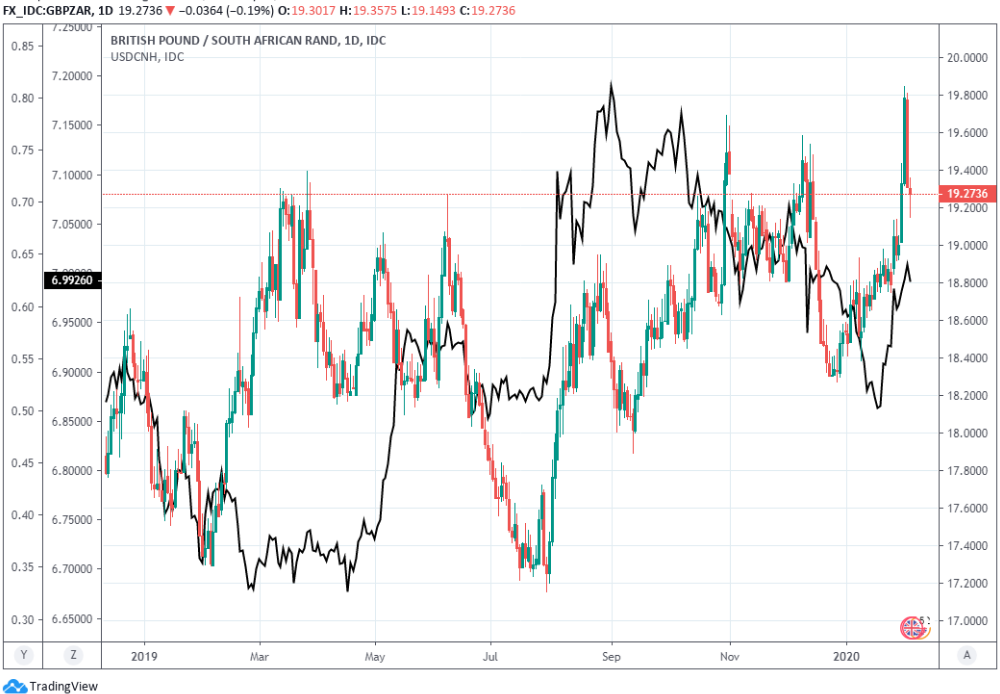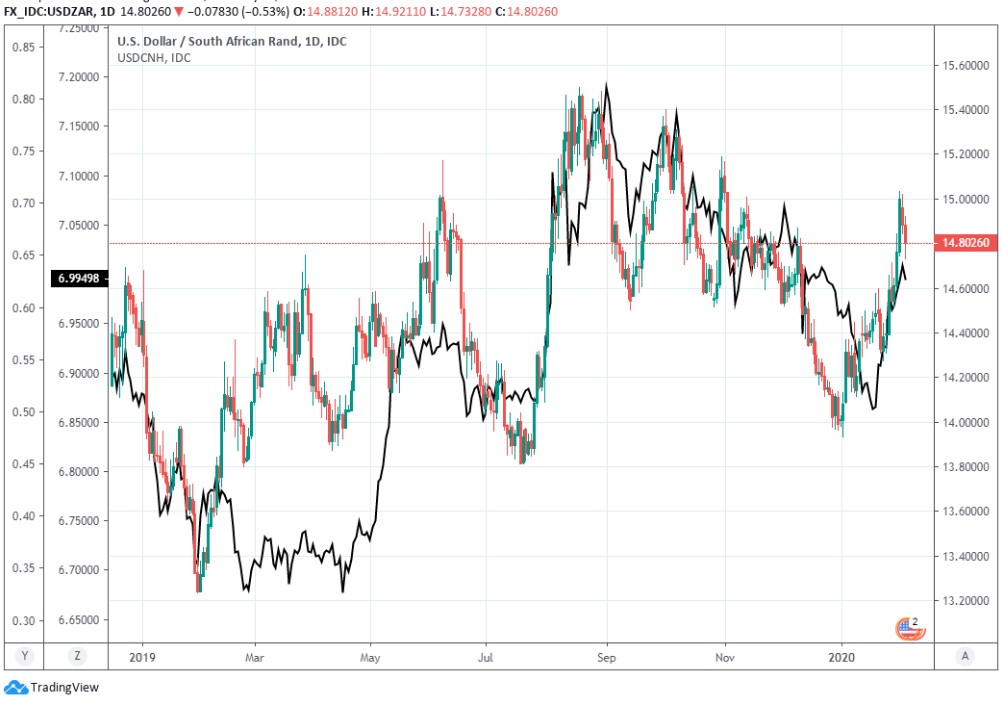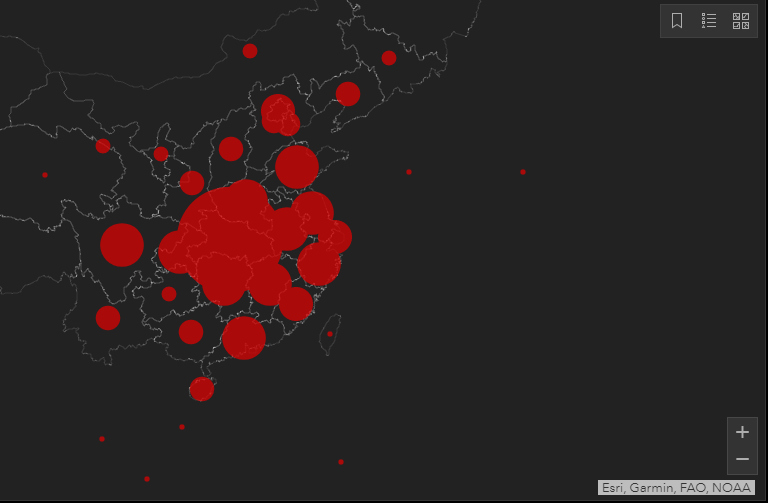South African Rand Tracks Chinese Yuan Higher but Growth and Rating Risks are Rising
- Written by: James Skinner
- GBP and USD lower as ZAR chases CNH recovery.
- CNH correlation offers the ZAR scope for more gains.
- But economic and ratings risks may crystalise in Feb.
- Load-shedding, China slowdown threaten SA economy.
- As Feb budget, March rating decision loom over ZAR.

Image © Adobe Images
- GBP/ZAR Spot Rate: 19.27, down 0.31% today
- Indicative bank rates for transfers: 18.60-18.73
- Indicative broker rates for transfers:18.98-19.10 >> find out more about this rate.
The Rand outperformed almost all of its rivals Tuesday amid a recovery of investor risk appetite that could lift the South African currency further over the coming days, although domestic risks could scupper any protracted upward move later this month.
Currencies were trading in a risk-on manner Tuesday, with the Pound, Aussie, and Canadian Dollars all higher against the greenback while the U.S. unit itself won back ground previously lost to the safe-haven Japanese Yen and Swiss Franc as panic over the spread of coronavirus appeared to recede. The Rand was higher against all of its major counterparts as well as most emerging market rivals, with only the Mexican Peso getting the better of the South African unit.
Markets are hoping the coronavirus epidemic in China will prove short-lived and that the subsequent return to normal will be quick, which are sentiments that might have been encouraged overnight by the latest declarations from the National Health Commission. Infections were at 20,438 as of midnight Monday, up from 17,205 the previous day, while the number of fatalities rose from 361 to 425, marking a slower rate of increase than that observed in prior days.
In addition, Chinese authorities have shown an early willingness to provide monetary support aimed at cushoning the blow of the virus.
"China moved to stimulate markets on Monday with the Chinese central bank unexpectedly cutting interest rates and pushing $171bn into the economy to counter the negative effects of the coronavirus outbreak. This move saw the Rand claw back some ground yesterday, recovering most of Friday’s losses," says Bianca Botes, a treasury partner at Peregrine Treasury Solutions.
Above: Pound-to-Rand rate at daily intervals, shown alongside USD/CNH rate (black line, left axis).
Coronavirus has brought China's economy to a standstill and there's still uncertainty about how long it will be before authorities have a proper grip on the situation although markets have calmed since the Peoples' Bank of China (PBOC) injected trillions of Yuan into the financial system to ensure adequate liquidity as investors returned from an extended New Year holiday.
PBoC intervention has helped keep the Yuan stable while the ebbing spread of the infection has incited hope that the worst might now be over, which is a boon for the Rand because it has a strong positive correlation with the Chinese currency. The trajectory of the USD/CNH rate, which is closely followed by both the USD/ZAR and GBP/ZAR rates, will be the most important influence on short-term price action in the Rand up ahead.
"The fix is some anchor, but is so without stopping the market moving higher (+/-2%). Enthusiasm to be long USD/China at present levels does not look strong. The virus is an undoubted tragedy and concern, but suggestions of it being a long-term weight on activity - without corresponding policy support, are beginning to be called into question," says Patrick Bennett, a strategist at CIBC Capital Markets, referring to the PBoC's modestly lower daily fix of the Yuan.
A Chinese government economist said last week that first-quarter growth could slip below 5% on an annualised basis due to the epidemic while the latest speculation is that the official growth target could fall as low as 4.5%-to-5% for the full year. And Goldman Sachs economists estimated Tuesday that global GDP growth could slow by 20 basis points as a result of the outbreak, although these numbers are all contingent upon a swift end to the crisis.
Above: USD/ZAR rate at daily intervals, shown alongside USD/CNH rate (black line, left axis).
South Africa's largest trade parter is China and economic growth would be placed at risk by any downturn in the Chinese economy.
But with the infection's spread showing signs of slowing and the PBoC as well as government rushing to support growth with monetary and fiscal stimulus, investors are for now at least willing to give the Chinese economy and currency the benefit of doubt.
"Having retreated from last Friday’s highs, USD/ZAR is firmly oscillating around 14.82, despite ABSA’s PMI falling to its lowest level in four months, as the generalised selling of risk assets lessened. Sentiment, however, remains bruised and any indication that cures for or containment of the coronavirus are failing, will trigger another sell-off," says Nema Ramkhelawan-Bhana, an economist at Rand Merchant Bank.
The Rand may benefit from any continued stabilisation of the Yuan but even if the coronavirus threat does subside further in the coming days the path ahead will remain littered with risks for the South African currency as each day brings the February budget and March rating decision from Moody's closer. And risks associated with those events will weigh increasingly in the minds investors if load-shedding continues at Eskom in the month ahead.
Eskom said Tuesday that 'stage 2 rotational load-shedding" would continue from 09:00 due to the equipment failures just days after CEO Andrew de Ruyter said power cuts could increase over the "medium-term" as the company takes on maintenance that has gone unattended to for too long, which is bad news for the struggling economy. And the newly-installed chief also hinted that Eskom could soon need further cash from the government, a revelation that won't be celebrated by Moody's or the Rand.
Above: Johns Hopkins University graph showing spread of coronavirus in and around China as of February 04, 2020.







